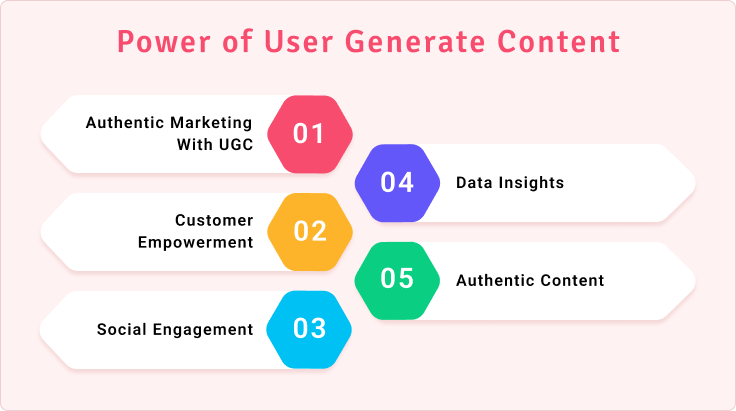
Get upto 50% off in New Year Offer

Get upto 50% off in New Year Offer

User-generated content material (UGC) has revolutionized advertising and marketing in the virtual age. Brands have shattered conventional advertising and marketing limitations and solid real connections through creative UGC content engagement.
This blog unpacks seven stellar UGC campaign examples that didn’t just boost engagement but converted emblem-target market relationships. We’ll find tested UGC marketing campaign examples, spotlight brands’ usage of UGC efficiently, delve into compelling UGC case studies, and demonstrate how UGC builds brand loyalty.
So, let’s get started! Here are seven inspirational customer-generated content campaigns that made unbreakable brand bonds through the electricity of patron content material.
Before diving into UGC campaign examples, it is important to outline what a UGC marketing campaign is. A UGC campaign is an advertising and marketing method in which manufacturers inspire customers, fans, or the public to create and proportion content related to the emblem or a selected subject matter. This UGC content engagement can take much bureaucracy, including pix, videos, opinions, blog posts, and social media posts.
Effective UGC campaigns involve
When performed right, a user-created content strategy gives customers a voice whilst providing proper natural content material which can raise marketing desires. It’s a win-win strategy that builds connections between manufacturers and their audiences.

In 2011, Coca-Cola had one of the most iconic UGC campaigns with “Share a Coke.“ They printed the most famous names in certain regions on their bottles, encouraging humans to “Share a Coke” with friends or partners whose names matched.
This authentic marketing with the UGC went viral globally as humans shared pics on social media with their customized Coke bottles. It sparked an enthusiasm that swept 80 nations, with Twitter, Facebook, and Instagram inundated with photographs of human beings enjoying a “Coke” with the man or woman whose name it bore.
Coca-Cola successfully fostered emotional connections at scale by personalizing the branding and empowering clients to share their products. It has become one of history’s most user-created content strategies, solidifying Coke as a general symbol of togetherness. Even nowadays, the “Share a Coke” concept lives on via constrained seasonal promotions.

National Geographic launched its #WanderlustPhotoContest on Instagram in 2014, requesting vacationers to share snapshots from their adventures. Participants who acquired the maximum likes have been entered to win an exclusive photo excursion with the publication.
The contest aligned perfectly with National Geographic’s brand reputation, and this is an example of how UGC builds brand loyalty. It engaged the platform’s visible-first consumer base by inviting them to publish lovely imagery from their travels. Not only did it produce an abundance of terrific UGC for the brand to reuse, but it also developed a following of journey-seekers.
By crowdsourcing content from fanatics, National Geographic highlights genuine travel moments but controls the general message around exploration and photography. The contest amplified the brand’s function as a leader in visual storytelling while bringing viewers along for trips worldwide.

Potato chip brand Lay’s is highlighted for its innovative “Do Us A Flavor” contest, which invites fans
to invent and vote on new seasoning combinations.
Starting in 2012, the annual contest encourages mass participation on social media as people submit and review flavor ideas. It successfully taps into snackers’ passion for experimenting in the kitchen while driving product innovation. Lay’s can test authentic marketing with UGC concepts on a large scale and select the most popular batches to manufacture.
In 2013, the first “Do Us a Flavor” campaign generated 3.8 million submissions. The contest made a comeback in 2014 and 2015, and this year, it was rebranded to “Passport to Flavor” for the 2016
Summer Olympics.
The contest boosted engagement and positioned Lay’s as a brand that values consumer creativity. The company demonstrated an understanding of constantly evolving taste preferences by crowdsourcing flavours. The Do Us A Flavor campaign has become a prime example of how to spark conversations and crowdsource new offerings through UGC.
Also Read | What is Google Perspectives and How It Affect Content Strategy

Sportswear brand Nike launched its influential Better For It campaign targeting female athletes. The initiative paired professional storytelling like the Margot vs Lily series with UGC to inspire women with motivational narratives.
It invited the sharing of personalized fitness journeys using #betterforit and developed an active community of support. Just two months after launching, Nike saw a 20% boost in its women’s division due to authentic storytelling and crowdsourced content demonstrating real change.
The campaign celebrated diversity and perseverance through both scripted and organic stories. It highlighted how UGC builds brand loyalty when uplifting shared experiences.

In 2014, Starbucks launched a very successful UGC campaign called the #WhiteCupContest. They challenged customers to get creative by drawing pictures on plain white cups for a chance to have their designs turned into official reusable cups.
Thousands of customers participated by uploading pictures of their decorated cups to Instagram and Twitter using the branded hashtag. Fan art ranged from landscapes to portraits to abstract doodles, showcasing the diverse talents within Starbucks’ fan base.
The campaign achieved massive engagement on social media as friends and followers voted on their favourites. It was a viral success that highlighted the creativity of Starbucks customers while promoting the brand’s image as a community hub for artists. Winning designs were later produced as limited-edition merchandise, further solidifying the positive connection between the brand and fans.
Starbucks skillfully fostered valuable genuine relationships through one of the earliest and most well known UGC marketing contests by giving their customers a creative outlet and platform. It’s arguably one of the most successful UGC campaign examples to date.

Fashion house Marc Jacobs made waves in 2014 with its social casting call for new models using #CastMeMarc. The campaign invited fans to share photos of themselves on Instagram and Twitter for a chance to walk in the brand’s next show.
Within just 24 hours, Marc Jacobs received over 15,000 submissions showcasing diversity and beauty from all over the world. By moving traditional casting online, the campaign introduced fresh new faces outside the industry directly to their audience.
It aligned with emerging trends in social media scouting while also positioning Marc Jacobs as pioneering and inclusive. The #CastMeMarc hashtag invited potential clients to visualize themselves within the glamorous world of high fashion in an accessible way.

Old Spice gained traction with a series of commercials featuring actor Isaiah Mustafa responding to comments in real-time. The company invited fans on Facebook and Twitter to interact directly with “The Man Your Man Could Smell Like” via UGC.
By keeping response times fast, Old Spice fostered an interactive experience that built massive social followings quickly. It differentiated the brand as humorous and conversational and showed audiences they had a direct line of communication to share feedback and receive personalized replies.
The campaign highlighted how UGC builds brand loyalty when a brand participates meaningfully in two-way dialogues around shared jokes and references from the commercials themselves.
Also Read | What is Infographic? : Meaning, Uses, Content Marketing, Benefits, and More

As these case studies show, thoughtful UGC campaigns humanize brands and build valuable relationships. They empower customers as brand ambassadors willing to authentically represent products through their own Stories, increasing reach. When crafted responsively, social media UGC examples foster genuine two-way communication that translates to higher trust, loyalty, and mutually beneficial longevity between companies and their communities.
User-generated photos feel more authentic than advertisements to as much as 76% of Gen Z and millennials according to studies. When customers openly discuss brands through advocacy rather than paid promotions, others recognize the validity. UGC gives followings and potential buyers social proof from real people in their networks.
By handing over creative control to audiences, brands place value on customer voice and individual expression. It makes participants feel invested in shared brand Stories rather than passive observers. UGC campaigns treat communities as partners rather than nameless demographics, building dedication to causes.
Hashtagged UGC spreads organically across networks as friends interact. It supercharges reach far beyond owned pages as engaged customers amplify campaigns voluntarily. Carefully curated user-created content strategy maintains momentum for prolonged periods through highly shareable quality posts that keep dialogues buzzing.
Analysing UGC submissions provides a wealth of first-party marketing data. Geographic and demographic trends emerge in content that reveal interests down to granular psychographics. Businesses gain profound clarity around targeting by observing grassroots habits within self selected fan cohorts.
Rather than paying for staged photoshoots, companies expose target authentic marketing with UGC to get real customer journeys. It boosts relatability as followers compare their own stories to shared experiences of everyday people just like themselves growing affinity through subtle familiar nods.
The success of these UGC campaigns underscores how strategic customer involvement shapes marketing’s future. Whether it’s tapping creativity or enabling advocacy, savvy brands are empowering their audience through co-creation.
So if you are seeking authentic marketing with UGC or wish to implement an interactive user-created content strategy, these real-world examples offer inspiration. Study how these brands built formidable engagement through UGC and sculpted voices that echo meaningfully across social media and popular culture.
Most importantly, unpack how these UGC content trailblazers forged formidable loyalty by making customers collaborators instead of just consumers. Because marketing crowded out by traditional
advertising noise needs to speak with the soaring volume of the people. And UGC builds that indispensable megaphone!

Streamline your marketing efforts with AI-powered working design — Organize, collaborate, and optimize your marketing campaigns all in one place!

Join now to shape the future of MangePlus
Don’t miss out
Content Writing | SEO | SEM